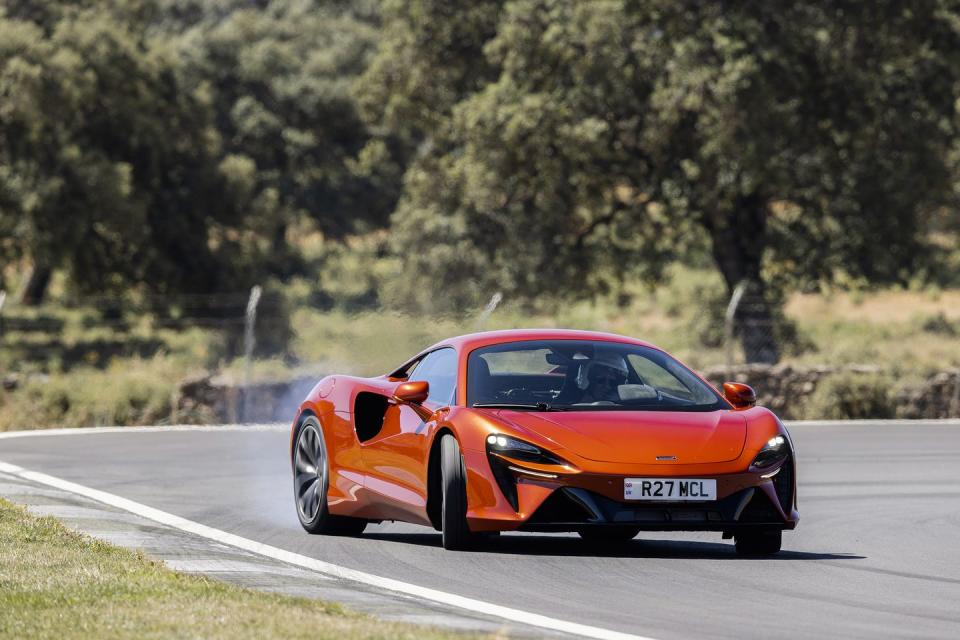The McLaren Artura Meets Spectacular Expectations


Ever wonder how real racers find that brake point? The best can push it by a hundredth of a second or even a thousandth. I’ve asked a few how they do it, and the answers vary. But the truth is, finding that precise brake point is as impossible to describe as entropy or string theory. The driver knows how much aero and grip his race car has and what angle and condition the tarmac is affording him. Then, and only then, the Chief Commander in the Sky tells the driver’s brain to tell his toe to press the brake now.
This story originally appeared in Volume 12 of Road & Track.
SIGN UP FOR THE TRACK CLUB BY R&T FOR MORE EXCLUSIVE STORIES
The Chief Commander in the Sky has no such discussions with me. And my sense of grip in a car is as rudimentary as just about any automotive journalist’s. That’s why the Chief Commander invented carbon-ceramic brakes, Pirelli P Zero Corsa tires, and a racing coach with a loud voice that shouts “Brake now! Now! Now!”
I’m in Spain at Ascari, a club track that mashes up all your favorite corners into one 3.5-mile ride with two hairpins that I just can’t quite figure out. I’m feeling confident, because I have just spent two hours on the area’s mountain roads in the new McLaren Artura.

To paraphrase Bob Dylan, this is a new day for McLaren, that little supercar maker that creates a big noise in the marketplace (and, not insignificantly, in Formula 1). More than that, this is potentially the beginning of a new chapter in the world of supercars. McLaren has a craggy, brilliant lineage that features at least one industry-defining car, the inimitable McLaren F1, and a succession of truly excellent sports cars: the near-perfect driver’s car in the 570S; the nearly untouchable 720S, which remains my personal favorite; and a half-dozen others. Most McLarens on the road today, if not all, will go down in history as the most fascinating examples of this era, no matter what happens to the company itself.

McLaren has been through tough times. This is not news. The automaker has flirted with oblivion and turned to the Saudis for financial help, and as I’m in Spain, there is no CEO in place. The launch of the hybrid Artura—considered by some wags to be a make-or-break vehicle for the company—had been delayed by factors both outside McLaren’s control and, to a lesser degree, inside it.
A few days before I drove the Artura in Spain, a handful of English journalists were testing the car on the same circuit. The software bedeviled the writers and bricked the cars on occasion. Problems with a fuel rail and an oil cooler led to fires in two vehicles. Teething problems for a new launch of hand-built, small-batch supercars are nothing new, but when all of McLaren’s recent issues stack up, fans get nervous.

But none of that drama matters today. Many miles before I asked in vain for the good Lord to telegraph me the brake point at Ascari, I was bounding and raging along a hot road in Spain, bearing witness from the driver’s seat to the new history of the very British brand with the rich motorsport heritage. McLaren dabbled in hybrid power a decade ago with the limited-run P1 hypercar. But the Artura is the company’s first mainstream hybrid.
Built on an all-new carbon-fiber monocoque, with a surprisingly sleek compartment, the Artura is a bright look at the company’s future. As I toggle between Comfort and Sport modes and push the limits of the Pirelli P Zeros between Spanish villages, I realize I’m driving the most complete sports car McLaren has ever made. It gets to 60 mph in just under three seconds and has a top speed of 205 mph. The electrohydraulic steering is precise and full of all the right feeling, and after getting used to the resistance, the brakes will tear out your eyeballs. The Artura is all the things it needs to be to meet spectacular expectations: light, lithe, powerful, and a vivid drive.
Also, somehow, it is a more mature product than anything McLaren has produced in years. Gone are the hacked-together interior components and obviously third-party interfaces. This is a real interior built onto a killer platform.

It can run at every level with its competitors. The Ferrari 296, also a hybrid with a 3.0-liter V-6, is more powerful and faster, but I’m not sure that matters. The truth is, if you’re even in the hunt against Ferrari, you’ve made a legit case that you belong. In the Huracán, Lamborghini has developed a legitimate performance platform. The Artura, the natural successor to the 570S, is a legitimate option not just for Ferrari and Lamborghini owners. It is also—and may God and every Porsche enthusiast strike me dead for saying so—a logical next step for a 911 owner, who is now spending just about as much as the Artura buyer. The McLaren lists for $237,500; the Porsche 911 Turbo S is $223,000, give or take; and the Ferrari 296 is an astounding $323,000.
The Artura’s 120-degree vee peaks at 580 hp at 8500 rpm. On the road, the throttle response is linear and the pickup instant. A 15.4-kg, 94-hp electric motor sits in front of the mid-mounted V-6, separated by a clutch. It blasts torque instantly, taking power from a 7.4-kWh battery pack tucked under the seats. In all, the Artura generates 671 hp.

There’s no reverse gear (the e-motor simply spins in the opposite direction), which saves weight. At a claimed 3303 pounds, the Artura weighs roughly the same as the 570S. And with 109 more horsepower, the new hybrid has a significant weight-to-power advantage over the old car. It can cover more than 10 miles on electricity alone at up to 81 mph. In Comfort mode, the V-6 switches on and off depending on throttle input. Sport and Track settings run the vee at all times and divert power to replenish the battery.
That brings us back to the track, with the driving coach beside me and the two devilish hairpins that I can’t quite figure out. The carbon-ceramic brakes are for purists. Unlike in the Ferrari 296 GTB, there is no brake-by-wire or energy recapture from the brakes. That leaves some efficiency on the table for Ferrari to boast about, but the truth is, the braking in the Artura is ridiculous.
In Track mode, I become greedy. The balance of the car, the steering feel, and the brakes—as well as fresh Pirellis—make me think I can push past that brake point, that there is infinite track ahead of me. No matter how much the car and the instructor yell, the Artura has convinced me I have talent that just doesn’t exist.
While there are sublime angles to the car, there are also elements I wish were more objectively beautiful. The McLaren grille needs a refresh, and it shows on the Artura. But let’s be clear: The Artura is a great new supercar, and it represents the future of a storied company that has held true to its roots (it is alone among OEMs that have so far declined to make an easy-profit SUV).
Will it be enough to save the company? Let’s hope so.

You Might Also Like

 Yahoo Autos
Yahoo Autos 